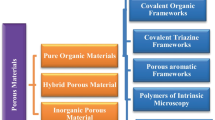Abstract
The nonisothermal and isothermal degradation processes of poly(ethylene terephthalate)/mesoporous molecular sieve (PET/MMS) composites synthesized by insitu polymerization were studied by using thermogravimetric analysis in nitrogen. The nonisothermal degradation of the composite is found to be the first-order reaction. An isoconversional procedure developed by Ozawa is used to calculate the apparent activation energy (E), which is an average value of about 260 kJ/mol with the weight conversion from 0% to 30%, and is higher than that of neat PET. Isothermal degradation results are confirmed with the nonisothermal process, in which PET/MMS showed higher thermal stability than neat PET. The polymer in mesoporous channels has more stability due to the protection of the inorganic pore-wall. These results indicate that mesoporous MMS in PET/MMS composites improve the stability of the polymer.
Similar content being viewed by others
References
Kresge C T, Leonowicz M E, Roth W J, Vartuli J C, Beck J S. Ordered mesoporous molecular sieves synthesized by a liquid crystal template mechanism. Nature, 1992, 359: 710–712
Beck J S, Vartuli J C, Roth W J, Leonowicz M E, Kresge C T, Schmitt K T, Chu C W, Olson D H, Sheppard E W, McCullen S B, Higgins J B, Schlenker J L. A new family of mesoporous molecular sieves prepared with liquid crystal templates. J Am Chem Soc, 1992, 114: 10834–10843
Chen J, Li Q, Ding H, Pang W, Xu R. Infrared Study on the Dehydroxylation of C60-Loaded MCM-41. Langmuir, 1997, 13: 2050–2054
Kumar D, Kamble V S, Gupta N M. The role of nanosize particles of Uranium Oxide in the adsorption/reaction of methanol over U3O8/MCM-48: FTIR Study. Catal Lett, 2003, 88: 175–181
Wu C G, Bein T. Conducting polyaniline filaments in a mesoporous channel host. Science, 1994, 264: 1757–1759
Kageyama K, Tamazawa J, Aida T. Extrusion polymerization: catalyzed synthesis of crystalline linear polyethylene nanofibers within a mesoporous silica. Science, 1999, 285: 2113–2115
Llewellyn P L, Ciesla U, Decher H, Stadler R, Schuth F, Unger K K. MCM-41 and related materials as media for controlled polymerization process. Stud Surf Catal, 1994, 84: 2013–2020
Frisch H L, Mark J E. Nanocomposites prepared by threading polymer chains through Zeolites, mesoporous silica, or silica nanotubes. Chem Mater, 1996, 8: 1735–1738
Mollers K, Bein T, Fischer R X. Entrapment of PMMA polymer in micro-and mesoporous Materials. Chem Mater, 1998, 10: 1841–1845
Moller K, Bein T, Fischer R X. Synthesis of ordered mesoporous methacrylate hybrid systems: hosts for molecular polymer composites. Chem Mater, 1999, 11: 665–673
Lehmus P, Rieger B. Nanoscale polymerization reactors for polymer fibers. Science, 1999, 285: 2081–2082
MacLachlan M J, Manners I, Ozin G A. New (Inter) faces: polymers and inorganic materials. Adv Mater, 2000, 12: 675–681
Spange S. Insulated nanowire bundles through consecutive template synthesis. Angew Chem Int Ed Engl, 2003, 42: 4430–4432
Nakajima H, Yamada K, Iseki Y, Hosoda S, Hanai A, Oumi Y, Teranishi T, Sano T. Preparation and characterization of polypropylene/mesoporous silica nanocomposites with confined polypropylene. J Polym Sci, Part B: Polym Phys, 2003, 41: 3324–3332
He J, Shen Y, Yang J, Evans D, Duan X. Nanocomposites structure based on silylated MCM-48 and poly(vinyl acetate). Chem Mater, 2003, 15: 3894–3902
Wu G, Run M T, Zhang D Y. CP 2 004 100 740 055
Run M T, Wu S Z, Wu G. Ultrasonic synthesis of mesoporous molecular sieve. Microporous mesoporous mater, 2004, 74: 37–47
Chen J H, Li C R. Thermal Analysis and Its Application. Beijing: Science Press, 1985 (in Chinese)
Coats A W, Redfern J P. Kinetic parameters from thermogravimetric data. Nature, 1964, 201: 68–69
Ozawa T. A new method of analyzing thermogravimetric data. Bull Chem Soc Japan, 1965, 38: 1881–1886
Nam J, Seferis J C. Generalized composite degradation kinetics for polymeric systems under isothermal and nonisothermal conditions. J Polym Sci, Part B: Polym Phys, 1992, 30: 455–463
Author information
Authors and Affiliations
Corresponding authors
Additional information
Translated from Polymer Materials Science and Engineering, 2006, 22(1): 64–67 [译自: 高分子材料与工程]
Rights and permissions
About this article
Cite this article
Run, M., Zhang, D., Wu, S. et al. Thermal decomposition of poly(ethylene terephthalate)/mesoporous molecular sieve composites. Front. Chem. Eng. China 1, 50–54 (2007). https://doi.org/10.1007/s11705-007-0010-z
Issue Date:
DOI: https://doi.org/10.1007/s11705-007-0010-z




